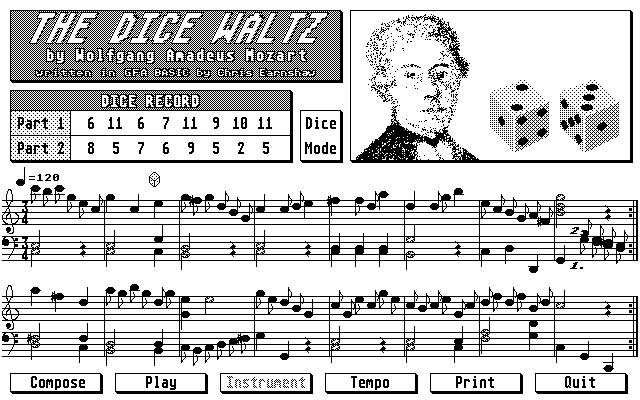Last update : August 27, 2013

Dice
The idea of the musical dice game is to cut and paste prewritten measures of music randomly together to create a piece of music. The random generation is done by a dice roll. The sum of the thrown numbers is looked up in a scoring table to determine which measure to play.
Today, its W.A. Mozarts (1756-1791) “Musikalisches Würfelspiel” which became famous and succesful. This mucical dice game was first published in 1793, two years after the death of Mozart. The original manuscript nor a direct reference to Mozart were ever found, but his authorship is no longer questionned by musicologists (Köchelverzeichnis KV1 Anh. 294d, KV6-516F).
IEEE Computer Magazine 1991
I first heard about Mozart’s dice composer in 1991. The july issue of the Computer magazine Vol.24 No.7 published by the IEEE Computer society was dedicated to computer-generated music. The project overview of Stephen W. Smoliar “Algorithms for musical composition: a question of granularity; pp.54-56” mentionned Mozart’s work.
The same year (1991), Chris G. Earnshaw from Cambridge, developped a computer implementation of Mozart’s dice game as a public domain program for the Atari computers. His version was based on the 1798 edition by Simrock in Bonn (reprinted by the Liverpool Music Press) of Mozart’s “Instructions to compose without the least knowledge of music so much german waltzer or schleifer as one pleases, by throwing a certain number with two dice” .
Other programmers have written before him versions for the BBC micro and for the Sinclair Computer.

Software for the Atari Computer 1991
In the mean time, many computer implementations of Mozart’s Würfelspiel have been published on the web. The most interesting related www sites are shown below :
- Noise Watchers, Arthur Stammet (Luxembourg) : Musikalisches Würfelspiel sous MaxMSP
Die erste Fassung des Programmes wurde am 26.11.2006 während eines Konzertes in der Philharmonie Luxemburg Festival “rainy days 2006”) vorgestellt. Die neue Fassung des Programmes wurde im Mai 2009 während der Foire de Printemps in Luxemburg vorgestellt und mit zwei Schülergruppen experimentell erforscht. - John Chuang: Mozart’s Musikalisches Würfelspiel
http://sunsite.univie.ac.at/Mozart/dice/
This site is a very clever MIDI implementation of the game and allows you to compose your own Mozart minuet. - Zsó Ruttkay and Bram Boskamp: Composing Mozart variations with dice
http://www.cwi.nl/~zsofi/mozart
A very nice implementation of Mozart’s game; the site is dedicated to mathematical challenges and educational experiences related to musical dice games. - Nate C. Burgess: A genetic algorithmic variation of Mozart’s Dice Game
http://www.excelsus.com/~cloudman/artist/
Interactive genetic music composition; B.S.degree in computer science 1997 - Richard Graf : Mozart Würfelspiel
Bei diesem Mozart Würfelspiel wird nicht gewürfelt, sondern komponiert! - Katalin Szőke, Meral Yasar, István Kovács : Mozart Interactive
first release in 1996 - Ivars Peterson : Mozart’s Melody Machine
AAM : The Mathematical Association of America
Math Trek, Science News Online, Sept. 1, 2001 - Dr. Willis Wager : Composers and Crapshooters
Carousel Publications, Ltd
Games to Compose Music from Mozart and Joplin - Michael Hammer : Taking a Chance with the Music: Mozart’s Dice Game
contribution in Pianonoise - Jonathan S. Simon : The Mozart Dice Game
applet requiring the JSyn Plugin from SoftSynth.com - Amaranth Publishing (S. Goodwin) : Musikalisches Würfelspiel
Windows version of thie dice game - Andrew Troedson : Mozart Dice Game
realisation of Mozart’s design in jMusic - Robert Xavier Rodríguez : Musical Dice Game
written in response to a commission from the Dallas Symphony Orchestra in honor of the 250th anniversary of Mozart’s birth - Andreas Lindahl : Mozart’s Dice Game
iPhone application - Dennis Pajot : KV.Anh C30.01 Musikalische Wureslpiel Dice Game
article in Mozart Forum - Craig Stuart Sapp : Musical Dice Games
Musical Information (Mus 253/CS 275A) - Hideo Noguchi (Kobe/Japan) : Mozart – Musical Game in C K. 516f*
scientific contribution 1997 - Kevin Jones : Dicing with Mozart: Just as whimsical musicians in the 18th
NewScientist, Physics & Math, 14 December 1991 - Chris Yavelow : CyberMozart®
Algorithmic composition in the style of Mozart An implementation of “Mozart’s Musical Dice Game” For Macintosh Computers* - Christoph Reuter : Die Musikalischen Würfelspiele
Artikel mit chronologischer Liste der heute noch bekannten Würfelspiele - Axel Berndt, Prof. Niels Knolle : Das “Musikalische Würfelspiel”
mit kommentiertem JAVA Quelltext

W.A. Mozart
Mozart was not the first composer who was interested in chance music and mathematical composition. Other known authors are A. Kircher (1650), Mizler (1793), J. Haydn (1793), F.G. Hayn (1798), J.C. Graf (1801), C.H. Fiedler (1801), L. Fischer (1801), A. Calegaris (1801) and G. Catrufo (1811). The best documented historical work is Johann Philipp Kirnberger ‘s “Der allezeit fertige Polonoisen= und Menuettencomponist” published in 1757.
Schott Music, Mainz, published a software about musical dice games for Windows computers : Musikalische Würfelspiele, von Mozart, Haydn und anderen großen Komponisten. Aus Tabellen werden Takt-Kombinationen gewürfelt, die so klingen, als wären sie ganz individuell komponiert. Available on amazon.de.
